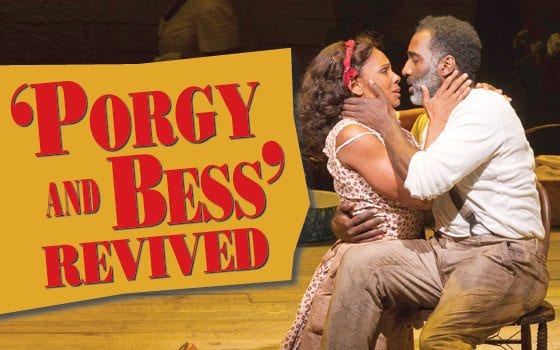Director Diane Paulus hits the refresh button on a Gershwin classic

Director Diane Paulus hits the refresh button on a Gershwin classic
In the beguiling opening scene of the American Repertory Theater production, “The Gershwins’ Porgy and Bess,” Clara, the wife of fisherman Jake, strolls across the stage singing “Summertime” to her infant son. In one of many seductive moments in this sublimely staged production, Nikki Renée Daniels, a tender Clara, turns to show the baby’s smiling face as she croons the song.
Directed by Diane Paulus, the ART adaptation is an intimate rendering of the production that George Gershwin described as “a folk opera.” Contrary to rumors, ART artistic director Paulus and her collaborators, Pulitzer Prize-winning writer Suzan-Lori Parks and two-time Obie winner Diedre Murray, have been faithful to the traditional production.
All the beloved songs are intact, although the ART adaptation of “Porgy and Bess” is an hour shorter than most productions in its 75-year history, running two hours with a 15-minute intermission.
In his popular 1925 novel, DuBose Heyward, a white native of Charlestown, S.C., created the love story of Bess, a prostitute, and Porgy, a crippled beggar, and the African American enclave of Catfish Row, a poor fishing village on the outer banks of Charlestown. Heyward wrote the libretto for the Gershwin opera and also penned many of its most memorable lyrics.
George Gershwin’s score blends elements of classical Italian opera, Yiddish music and African American musical traditions, including folk music, gospel songs, blues, spirituals and the quintessential American art form — jazz.
Like the original production, which had a sensational debut at Boston’s Colonial Theatre in 1935, the ART adaptation will move to Broadway. On stage in Cambridge until Oct. 2, the production will begin Broadway previews in December.
The ART adaptation enriches its visual and aural poetry with the choreography of Ronald K. Brown, which, like the music, springs from African and African American sources.
Lighting by Christopher Akerlind, sets by Riccardo Hernandez and costumes by Esosa blend in seamless harmony throughout the ART production. The strong cast of 22 singing and dancing actors is accompanied by an 18-member pit orchestra conducted by Sheilah Walker.
The stage is covered by a scrim painted to resemble a wall of birch logs and wood pilings jut out to suggest a dock. As the scrim rises, we enter a day in the life of Catfish Row. The women cluster together and the men gather around crap-shooting Sporting Life (David Alan Grier), who wears a snazzy yellow suit and a bowler hat.
Holding dice in one hand and drugs in another, Grier injects the first charge of star wattage in the production, which features Broadway luminary Audra McDonald as Bess, Norm Lewis as Porgy and Phillip Boykin as Crown.
Brown’s choreography transforms the separate circles of men and women into taunting, teasing couples. Clara’s baby cries at just the right time to trigger Jake, the charismatic Joshua Henry, to sweep up his son and lead the saucy ensemble number, “A Woman is a Sometime Thing.”
Later, when Jake and his crew prepare their nets, he leads the gospel-inflected chant, “It Takes a Long Pull,” flavored with a waft of Caribbean rhythm. The infectious song ends too soon.
Boykin is persuasive as Crown, Porgy’s menacing rival for Bess. During a hurricane, he bursts into Catfish Row, where the people huddle and pray for relief from the storm, and rouses them with his brazen, “A Red Headed Woman.”
Grier is superb in his role. In a later scene, he channels big-band leader Cab Calloway’s “diddy-wa-doo” style and turns the men into an orchestra of shimmying bodies to “It Ain’t Necessarily So.” When he sings “There’s a Boat That’s Leaving Soon for New York,” he tempts Bess with a mix of swagger and restraint.
And he is a deft mime as Mariah, the sassy and soulful matriarch of Catfish Row, cuts him down to size in the show’s great comic episode, “I Hate Your Strutting Style.”
NaTasha Yvette Williams (whose twin sons alternate as the baby) is a captivating Mariah. She embodies in her ample girth and heart the resilience of the denizens of Catfish Row, which is the true subject of the ART production.
The villagers come alive in every scene — from the keening aria of Serena (Bryonha Marie Parham) over her dead husband, killed by Crown, to the sublime chants of the street vendors. Cedric Neal ends his sinuous cry, “I’m talkin’ about devil cra-abs” with its traditional high-pitched whoop. A glowing Andrea Jones-Sojola peddles her strawberries and Phumzile Sojola hawks his honey jars with flair.
Attired for a picnic in straw hats, dresses and suits, the ensemble becomes a joyful pastel pageant. McDonald’s Bess gets to stretch her long dancing legs in a rare moment of jubilation, drawn into the communal dancing by Mariah.
One regrettable amendment in this production is the insertion of trite dialogue in some scenes that states the obvious and falls flat. Clara tells Jake, “Be careful,” as he heads out to sea despite an approaching storm. Mariah explains her overtures to Bess, saying she wants her to “feel welcome.” Bess assures the neighbors, “I’m good for Porgy.”
Mariah is the lodestar of this “Porgy and Bess,” a production that is more about the struggles, trials and resilience of Catfish Row’s residents than the love of its namesake couple.
In the overture to Act II, a rhapsodic instrumental reprise of “Bess, You Is My Woman Now” is a reminder of what is rare in the interaction between this Bess and Porgy — joy.
McDonald and Lewis render their characters as intense but remote figures.
Lewis is a dignified and determined Porgy with an angry edge and he sings that way. As he intones, “I gotta’ travel that lonesome road,” his face is lit to emphasize his isolation. Later, as he celebrates his life with Bess by singing “I’ve Got Plenty of Nothing” in his rich baritone, his smile expresses more triumph than joy.
McDonald’s Bess is taut and tough, her beautiful face fixed in a scowl and streaked with a scar that resembles war paint. When Porgy first beckons her, his arm outstretched, she crosses the stage to embrace him, but the stark coupling lacks any hint of desire.
Yet all this distance melts away as McDonald bursts into “Bess, You Is My Woman Now.” With her rapturous lyric soprano rendering of this gorgeous ballad, McDonald confirms the enduring power of this “folk opera” and the love story at its heart.






